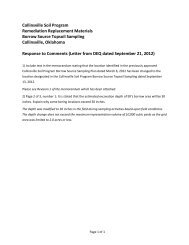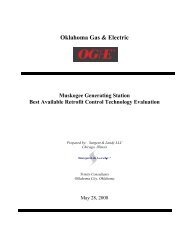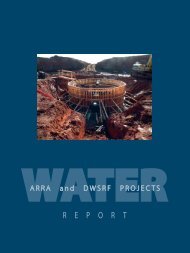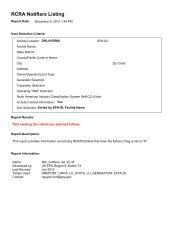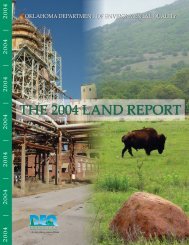Technical documentation and software quality assurance for project ...
Technical documentation and software quality assurance for project ...
Technical documentation and software quality assurance for project ...
Create successful ePaper yourself
Turn your PDF publications into a flip-book with our unique Google optimized e-Paper software.
J. Zeeuwen <strong>and</strong> B.J. Wiekema (1978)The measurement of relative reactivities of<br />
combustible gases, Conf. on the Mechanisms of Explosions in Dispersed Energetic<br />
Materials.<br />
FLARE (Jet Fire)<br />
Summary:<br />
Model calculates the size <strong>and</strong> shape of a flare or jet <strong>for</strong> gaseous releases from pipelines, tanks <strong>and</strong> twophase<br />
releases from tanks. Chamberlain (1987) empirical <strong>for</strong>mulas <strong>for</strong> vertical <strong>and</strong> inclined burns in a<br />
horizontal wind are used to describe the geometry of the flame.<br />
MODEL ASSUMPTIONS<br />
• Gas releases from pipe or tank<br />
• Choked <strong>and</strong> unchoked flow<br />
• Two-phase flow from tank<br />
• Flame assumed from open pipe rather than flare tip<br />
• Burning gas is assumed to behave similar to a hydrocarbon (methane, propane <strong>and</strong><br />
ethylene).<br />
• Visible flame described by a frustum of a cone<br />
MODEL INPUTS<br />
• inside diameter of the pipe or orifice (meter)<br />
• average wind speed (meter per second)<br />
• density of air<br />
MODEL DESCRIPTION<br />
Figure 6 shows the flow diagram <strong>for</strong> the flare. An in-depth description of the model is<br />
reported in Chamberlain (1987) <strong>and</strong> Lee (2001). Chamberlain’s model was selected over<br />
the alternative point source model since the latter is known to be insufficient within one<br />
to two flame lengths <strong>for</strong> short-term radiation levels although sufficiently accurate in the<br />
far field (Chamberlain, 1987). The Chamberlain better mimics the actual size <strong>and</strong> shape<br />
of a flare.<br />
A review of the literature in SFPE (1995) <strong>and</strong> Lee (2001) identified two versions<br />
of the model, Kalghatgi (1983) <strong>and</strong> Chamberlain (1987), both of which approximated the<br />
geometry of a flare as a frustum of a cone. While Kalghatgi’s used small burners in a<br />
wind tunnel, the main focus of Chamberlain’s work was on field trials at onshore oil <strong>and</strong><br />
gas production installations. Both models used empirically fit equations to describe the<br />
flame shape. In fact, Chamberlain uses Kalghatgi (1983) empirical equation to derive the<br />
flame length. Because Chamberlain’s work was more recent <strong>and</strong> involved larger scale<br />
testing, the Chamberlain model was selected <strong>for</strong> ALOHA to describe thermal radiation<br />
hazards <strong>for</strong> both flares <strong>and</strong> jets.<br />
From Chamberlain (1987), the gas velocity of the exp<strong>and</strong>ed jet, u j , is<br />
22<br />
€



